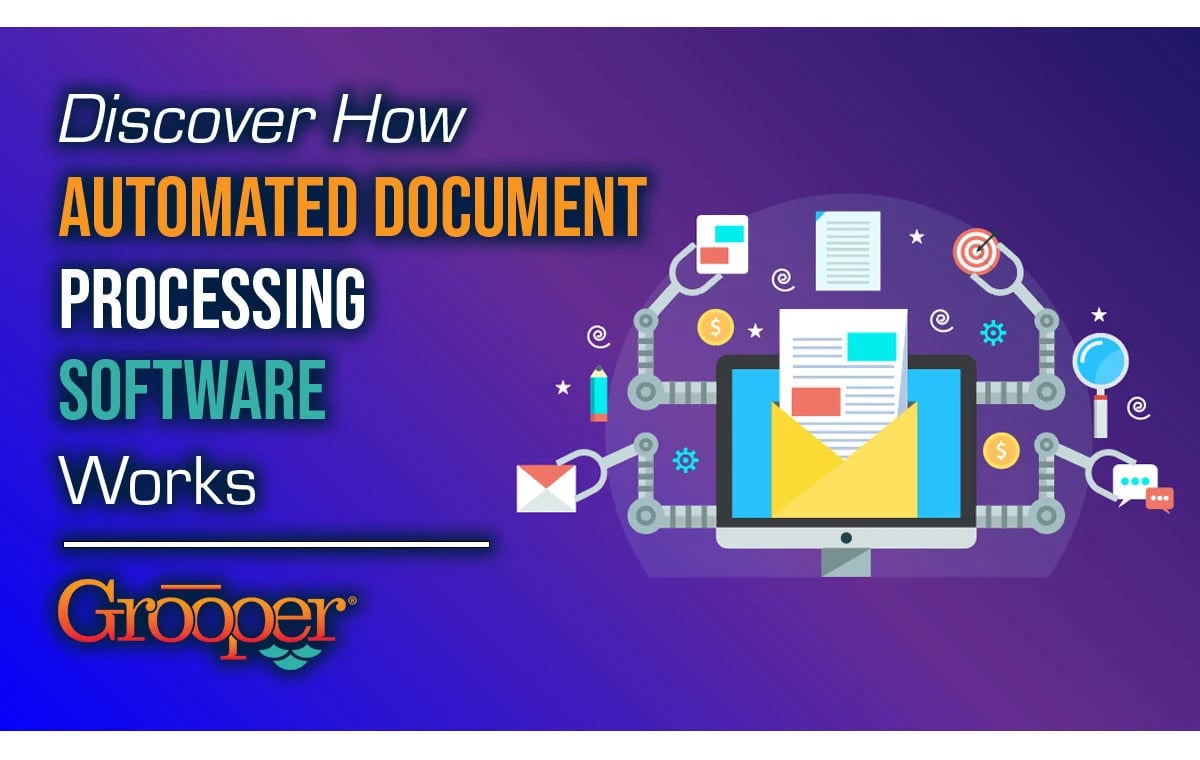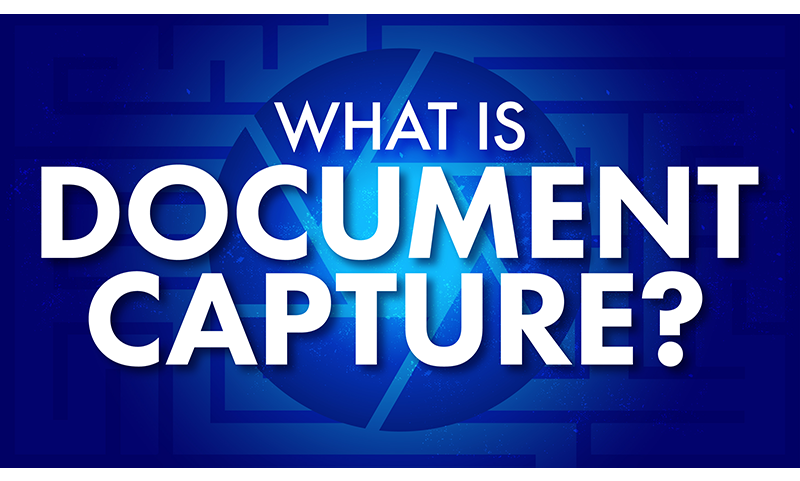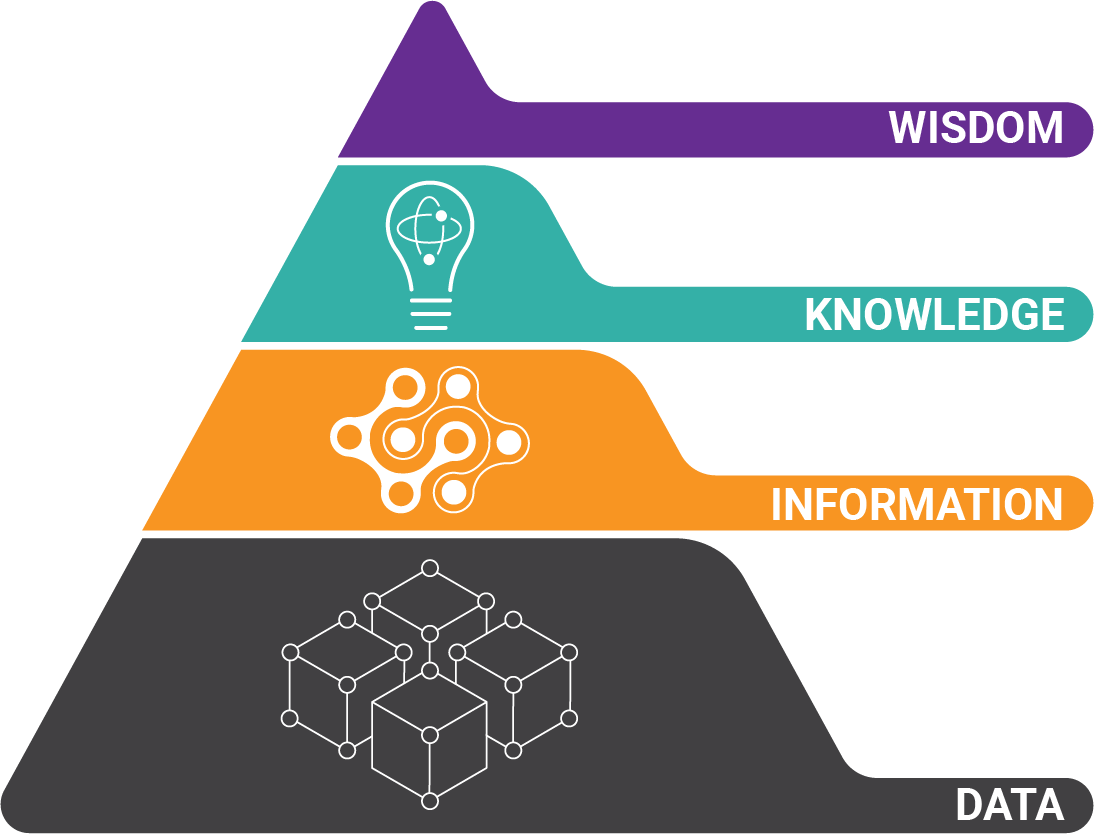Modern microfilm and microfiche conversion services offer digital archiving — and so much more.
We understand archived microform represents invaluable information you’re entrusted to preserve. Choosing the right vendor and the right time for conversion is of vital importance...
Table of Contents:
- 3 Reasons to Use Microfiche and Microfilm Conversion Services
- What is Microfilm?
- What is Microfiche?
- What is the Difference Between Microfilm vs Microfiche?
- What are the Similarities Between Microfilm and Microfiche?
- Why We're the Experts at Microfilm and Microfiche Conversion
What is Microfilm?
 Microfilm is a version of microform record storage that utilizes a roll of photographic film to store a copy of original hard copy papers in a much smaller format. Rolls of microfilm usually measure 16mm or 35 mm tall, which makes boxes of documents much easier to store and archive.
Microfilm is a version of microform record storage that utilizes a roll of photographic film to store a copy of original hard copy papers in a much smaller format. Rolls of microfilm usually measure 16mm or 35 mm tall, which makes boxes of documents much easier to store and archive.
Normal size documents, such as 8.5 x 11 letter size pages, use 16mm film. But large-format documents, like architectural or engineering drawings, fit better on 35mm film. Rolls or reels of film can store up to 2,500 pages, or 500 drawings.
What is Microfiche?
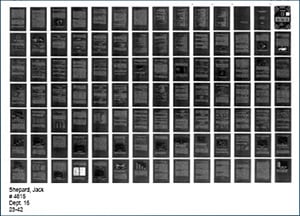 Microfiche is similar to microfilm but stores document images on flat sheets of microfilm and as a result, stores fewer images.
Microfiche is similar to microfilm but stores document images on flat sheets of microfilm and as a result, stores fewer images.
There are several kinds of microfiche sheets, but most sheets measure 4 by 6 inches and can store 100 letter-size document images at the most. As these are flat sheets, they can easily be stored by stacking them.
To assist humans and machines with quickly understanding what is contained on a sheet, there is a blank white area that can be labeled with a department's name, organization or person's name, case number, and date. (See example above.)
What is the Difference Between Microfilm and Microfiche?
While both microform materials are essentially scaled-down reproductions of normal-size documents, there are several noticeable differences between microfilm vs microfiche, which includes:
-
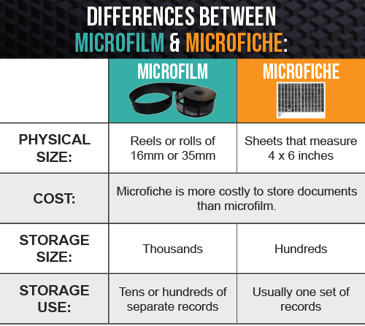 PHYSICAL SIZE: Microfilm comes in reels or rolls of either 16mm or 35mm film, and the rolls can measure up to 100 or 215 feet long when completely unrolled. But microfiche is much smaller; it comes in flat sheets of film that measure 4 by 6 inches.
PHYSICAL SIZE: Microfilm comes in reels or rolls of either 16mm or 35mm film, and the rolls can measure up to 100 or 215 feet long when completely unrolled. But microfiche is much smaller; it comes in flat sheets of film that measure 4 by 6 inches. -
COST: Microfilm costs less than microfiche to scan and store, based on image by image comparisons.
-
STORAGE SIZE: Microfilm stores up to thousands of document images, while microfiche stores tens or hundreds of images.
-
STORAGE USE: As the storage capacity for microfilm is greater than microfiche, film usually contains tens or hundreds of separate documents. Microfilm can contain groups of documents that have fewer pages, but are larger in the total quantity.
However, fiche is normally used for one separate batch of documents that number up to 100 pages. A patient's records are a good example of documents that would be stored on microfiche as that batch can be stored separately from someone else's records.
What are the Similarities Between Microfilm and Microfiche?
As there are differences between microfilm vs microfiche, there are many parallels the two share. Among them are:
-
STORAGE REQUIREMENTS: Microfiche and microfilm must be stored in rooms away from sunlight that have low humidity levels (below 50%), and cool but not cold temperatures (below 70 but not freezing, either). If these conditions are not met, the information on microform is at risk of being destroyed. More on this here.
-
READ BY: Both can be read by using microfilm reader/printers. They can also be read by the low-tech way - by just using a magnifying glass or loupe and the naked eye.
-
DIGITIZATION: Both forms of micro data can be scanned with conventional scanning technology to store and read digitally.
Check Out Our Free Guide on Microfilm and Microfiche Conversion and Scanning:
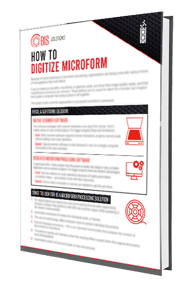
Download our helpful e-guide to microfilm and microfiche conversion! You will learn:
- 6 Things to Look for in a Microform Processing Solution
- The steps to expect in a microform conversion
- How to quickly fix conversion indexing mistakes
DOWNLOAD NOW!
Here are 3 Reasons to Use Microfiche and Microfilm Conversion Services:
- Environmental Factors Can Destroy Film and Fiche
- Improved Document Images through Microfiche and Microfilm Conversion
- Easy Access to Data on Microfilm and Microfiche
Reason #1: Environmental Factors Can Destroy Film and Fiche
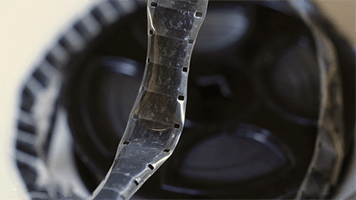 There are 3 film types; Silver-Halide, Diazo, and Vesicular. Each is susceptible to damage from a variety of factors which can be avoided.
There are 3 film types; Silver-Halide, Diazo, and Vesicular. Each is susceptible to damage from a variety of factors which can be avoided.
Film still appears to be a viable option for long-term storage. However, risk of loss through environmental factors is limited only by strict adherence to stringent storage policies:
-
Maintain offsite duplicate master copies
-
Use only approved storage containers and metal furniture in the vicinity of film
-
Monitored climate-controlled environment; temperature, humidity, lighting, and air quality
-
Do not store different film types in the same container
Here are 3 things that happen to film when not stored properly:
-
Silver Oxidation – Causes blemishes due to silver corrosion on film when storage room temperatures exceed 70°F or when relative humidity exceeds 50%.
-
Scratches and mold – Dust is a major cause of mold and abrasions on microfilm, microfiche, and aperture cards.
-
Redox blemishes – reddish circular microspot damage caused by chemical airborne pollutants.
While all types can be treated to reduce vulnerabilities from damage, digitizing microfilm or fiche may be a more cost-effective approach in the long run. Are you fully committed to proper storage?
Would you like to learn more about our microfilm and microfiche conversion services?
Reason #2: Improved Document Images with Microfiche and Microfilm Conversion
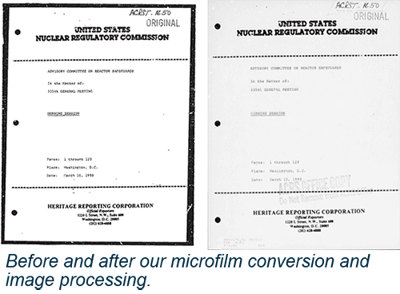 In most cases, the process of putting document images on film introduces artifacts that affect image quality. Dust particles, skewed images, scratches, and manual redactions make looking at microfilm and microfiche difficult. And if you need to perform optical character recognition (OCR) on these images, getting good accuracy is difficult.
In most cases, the process of putting document images on film introduces artifacts that affect image quality. Dust particles, skewed images, scratches, and manual redactions make looking at microfilm and microfiche difficult. And if you need to perform optical character recognition (OCR) on these images, getting good accuracy is difficult.
New advances in scanning software take advantage of technology like computer vision and image processing to make scanned microform images look even better than the original.
This makes highly accurate OCR and full-text searching possible. Here are just a few of the advantages of modern microfilm and microfiche scanning software:
- Scratch removal
- Warped image repair
- Restore damaged images
- Remove specs, blobs, and hole punches
- Cleanup borders
Reason #3: Easy Access to Data on Microfilm and Microfiche
Perhaps the number one reason to digitize microfilm and microfiche is making the data readily available to other software applications.
This is important for making archived records fully text-searchable and for integrating the data with databases and information management tools.

Electronic access to data contained in archived documents provides new sources of data for:
- Analytics
- Fast searching for discovering information
- Giving the public fast access to secure data
Digitizing records is also important for meeting government regulations, such as those declared by the National Archives Registration Administration (NARA), and for regulations that govern protected health and personal information.
Advances in scanning technology have unleashed a brand new way of digitizing microfilm and microfiche. Now, both the quality of digital images and the ability for very accurate OCR are many times better than previous solutions.
Better image quality and better OCR mean better data extraction.
Why BIS is the Expert at Microfilm and Microfiche Conversion:
-
We’ve been working with microfilm, microfiche, and aperture cards since the late 1980’s.
-
We’ve converted tens of millions of images of microfilm, microfiche and aperture cards. So we understand the value of storing important documents in physical format. However, we’ve also witnessed the incredible value of digitizing this information.
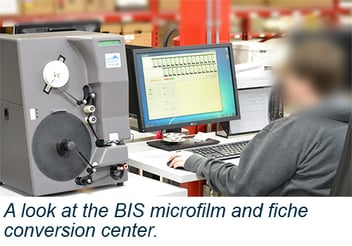 Until recently, digitization projects for archived records have been expensive and with too little value to show. If you’ve considered a large-scale microform conversion project in the past, then you know.
Until recently, digitization projects for archived records have been expensive and with too little value to show. If you’ve considered a large-scale microform conversion project in the past, then you know.
We’ve heard horror stories of projects taking years to complete and with terrible quality. And even if quality was achieved, efficient storage and retrieval of digitized microfilm adds another layer of cost and complexity.
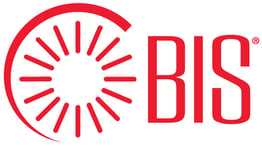 To make practical sense, microfilm, and microfiche conversion must provide more than just making digital copies.
To make practical sense, microfilm, and microfiche conversion must provide more than just making digital copies.
Today is a better time than ever for digitizing all types of microform. Advances in scanning and storage technology remove the high price tag and chaos associated with creating hundreds of thousands or millions of digital document images.
Learn How we Helped a Federal Government Agency Convert over 39 Million Pages of Microfilm in Under 2 Years!

In this case study, you will see how we helped a vital part of the U.S. Government:
- Overcome challenges with their microform data
- Improve document image quality
- Inject the data into their data management systems
DOWNLOAD NOW!
About the Author: Brad Blood
Senior Marketing Specialist at BIS


